Romsey Abbey: A House Divided, a House Preserved
by Moira Allen
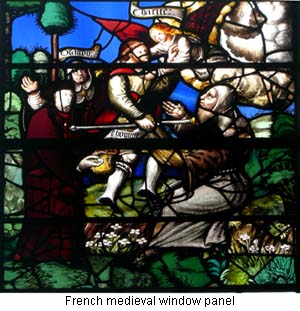 Sometimes, being a "house divided" is not such a bad
thing! In the case of Romsey Abbey in Hampshire, it proved that
house's salvation. Sometimes, being a "house divided" is not such a bad
thing! In the case of Romsey Abbey in Hampshire, it proved that
house's salvation.
Romsey Abbey was founded in Saxon times as a nunnery, but rebuilt
in Norman times to house not only the convent and its church, but
also the local parish church of Romsey. The convent occupied the
southern section of the building, while the parish church
occupied the northern side. Hence, when the abbey was
"dissolved" by Henry VIII in 1539, the town was in peril of
losing its only house of worship, and so the townsfolk were able
to successfully petition Henry to sell the building back to them
for £100. And so, instead of being sold off to one of
Henry's lords to become, at best, a manor, or at worst, be
stripped of its building stone, Romsey Abbey survived not only
intact but as a religious house.
The Saxon abbey was founded by King Edward the Elder, son of
Alfred the Great, around 907 AD. He established a convent of 100
nuns, with his daughter Elfleda as abbess. It is likely, however,
that there was already a religious centre on this site long
before the abbey was founded.
The abbey's early life was far from settled. Vikings frequently
raided the region, causing the nuns to flee to the safety of
nearby Winchester on more than one occasion. Perhaps more
detrimental, however, was the hostility of King Eadwig (953-959)
to the church. Eadwig was succeeded by his brother Edgar, who
complained:
All the monasteries in my realm, to the outward sight, are
nothing but worm-eaten and rotten lumber and boards; and what is
worse, they are almost empty and devoid of divine
service.
Edgar rebuilt and endowed at least 40 monasteries, including
Romsey, and united them under the Rule of St. Benedict (until
that time, monasteries in England could choose whatever rule they
wished). When his young son died, Edgar had him buried at Romsey
Abbey.
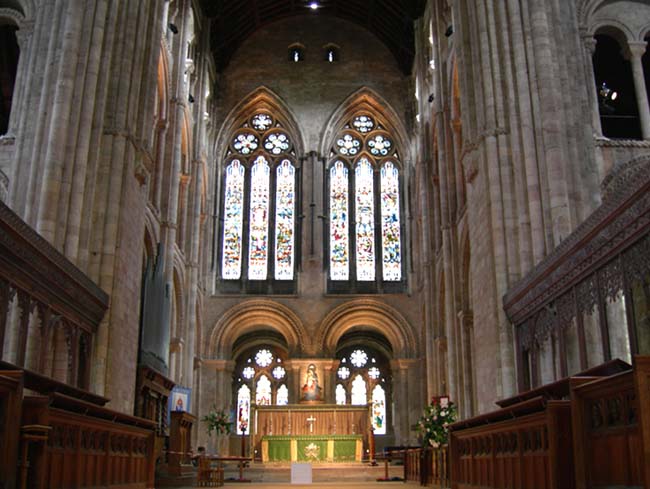
The Norman building was begun in 1120, and completed about a
century later. The building was probably sponsored by Henry I,
though no records exist to confirm this. Henry, however, had a
strong connection to the abbey through his wife, Queen
Matilda.
Matilda, who was originally known as Eadyth, was the daughter of
Queen Margaret of Scotland and a direct descendant of the Saxon
royal line. William II, son of William the Conqueror, visited
Romsey Abbey with an eye toward marrying Eadyth and hence
annexing the Saxon royal line to his own -- which would have been
a sound political move. Eadyth, however, was in the care of her
aunt Christina, a nun at the abbey, and Christina had other
ideas. She had no intention of letting her niece marry a man of
William's dissolute reputation; William was at odds with the
church for most of his reign, and was, according to the
Anglo-Saxon Chronicle, "hated by almost all his people." So, the
story goes, when William entered the abbey gardens to get a
glimpse of Eadyth, Christina threw a veil over the girl's head
and declared that she was already a nun. Apparently William
wasn't all that keen on the marriage anyway, and he didn't press
the issue.
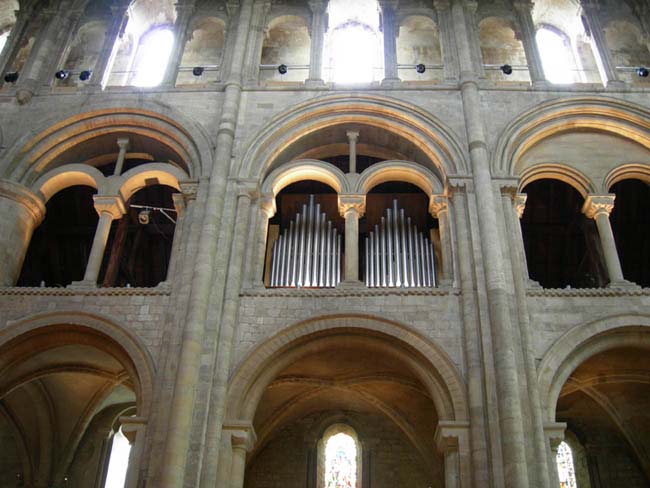
Shortly thereafter, William was shot with an arrow while
hunting in the New Forest, and his brother Henry assumed the
throne. He, too, saw the advantages of a marriage to Eadyth and
proposed -- and apparently Christina considered him a more
acceptable candidate. The only problem was that the story had
now gotten about that Eadyth had taken vows as a nun and could
not marry. Finally Eadyth herself wrote a letter to Archbishop
Anselm, stating that she had never taken vows or willingly worn
the veil. Her words must have been convincing, as Anselm himself
performed the wedding ceremony. Henry was not noted to be the
most faithful of husbands, but was heartbroken at her death in
1118 -- a death followed two years later by the loss of his son,
William, in the sinking of the White Ship.
The new Norman building was erected upon the same site as the old
Saxon building, and exhibits a wide range of styles, from Saxon
to Gothic. The visitor can't help but note that no two columns
seem precisely the same -- and some variations may simply
represent the whims of the architects. Of course, the building
has undergone many changes and revisions since its original
construction; a new roof was provided by Henry III, who
contributed oaks from the New Forest for its building, while the
present barrel roof dates from the 1860's. In the 1400's, the
north aisle was no longer sufficient to serve as the parish
church for the local population, so William of Wykeham granted
permission for it to be enlarged. The abbey once had a separate
bell tower, but this fell into disrepair after the Dissolution,
and a new central bell tower was erected; one can look up at a
lovely painted Jacobean ceiling that serves as the bellringers'
floor.
A House of Saints and Sinners
The early abbesses of
Romsey abbey were noted for their piety, and the abbey
contributed several saints to the Catholic roster, including
Merwenna, abbess during the reign of King Edgar. Most famous,
however, was Ethelfleda, the orphaned daughter of one of Edgar's
nobles and Merwenna's ward. Many miracles were attributed to
Ethelfleda; it was said that she could read the scriptures by
night by the glow that emanated from her fingertips. On one
occasion, she gave away the abbey's funds to the poor, yet the
treasury was miraculously refilled the next morning.
The convent flourished at least until the 14th century; in 1311,
the bishop decreed that it had too many nuns and could take no
more until its number returned to "normal" (possibly the 100 that
had originally been established). When the Black Death swept
England in the mid-14th century, however, the abbey was hit
hard; by 1478, only 18 nuns remained, and the number never rose
above 25 thereafter.
According to many historians, the abbey's population declined not
only in quantity but in quality. While nuns of the Saxon and
early Norman period generally had a genuine vocation, by the
Middle Ages convents had become a convenient place to dispose of
inconvenient women. Here, families could leave daughters who
were unlikely to attract husbands due to lack of looks, lack of
dowry, or mental or physical defects. Husbands could confine
unfaithful (or simply unwanted) wives to a convent, and many
widows had nowhere else to go. Guardians of heiresses often
confined such children to convents as well, in hopes of
inheriting their wealth if and when they took the veil.
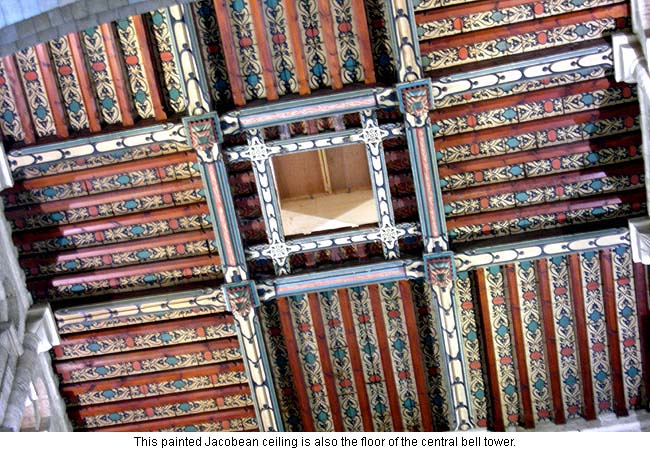
In addition, by the Middle Ages, education was no longer
considered essential for a well-born lady. Hence, while Saxon
ladies like Eadyth could read and write in more than one language
(Eadyth wrote her letter to Anselm in Latin), and Norman ladies
could at least read French, by the 14th century many nuns no
longer understood the Latin offices. In 1311, a bishop had to
translate his Latin instructions into Norman French, and in later
years few nuns even spoke that.
The rule of St. Benedict focused upon a balance of prayer, manual
labor, and study and meditation. Sadly, the well-born ladies of
the Middle Ages were ill-suited for any of these occupations.
Besides lacking the education to enable them to spend time in
study, they also had virtually no experience with (or interest
in) manual labor. Their hours must have seemed endlessly tedious
-- and nuns were recorded as attempting to alleviate their
boredom with such diversions as fine clothing and pets. On more
than one occasion, nuns were rebuked for bringing their pet dogs
to the services, and Abbess Walerand (1268-1298) was forced by
the Archbishop to give up her pet monkeys and was told she could
have no more than one dog -- and one maid! As early as 1138, a
church council forbade the wearing of furs, including squirrel,
ermine, marten, sable and beaver; in 1200, the wearing of
coloured headdresses and jewelry was also forbidden. Such
restrictions seem to have either lapsed or been ignored over
time, however, since one Agnes Harvey was bequeathed a red mantle
by the vicar.
Such troubles helped provide Henry VIII with an "excuse" to
disband the monasteries, though his primary goal was simply to
seize the vast wealth held by the church. Elizabeth Ryprose, the
last abbess of Romsey, made a last-ditch attempt to save the
abbey by having Henry reconfirm its charter, but she soon saw the
proverbial handwriting upon the wall and arranged to pension off
most of the abbey's servants and officials. Nothing else is
known of her fate or that of the remaining nuns, save one Jane
Wadham, who married the abbey chaplain, claiming that she had
been forced into the convent and did not feel bound by her vows.
Through this marriage, Jane became an ancestress of the St. Barbe
family, whose memorial can be seen in the abbey and whose lands,
Broadlands, have been closely associated with the Abbey over
time.
History in Nooks and Crannies
When you step into Romsey Abbey, you feel as if you are stepping
back in time. The building is quiet, with a pervading sense of
peace; one has no difficulty believing that God has been
worshipped here without interruption (though not, of course,
without controversy) for more than 1000 years. The building has
an almost Byzantine appearance, both inside and out; its massive
columns dominate the small space.
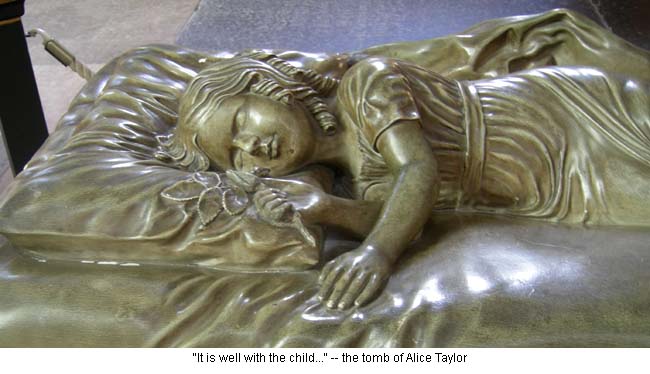
As you enter, one of the first things you'll see is the lovely
sculpture of a sleeping child. This is one of the abbey's most
noteworthy tombs: the resting place of Alice Taylor, who died of
scarlet fever in 1843 at the age of two. Her father, a local
doctor, was also a sculptor, and designed this tomb, inscribed
with the words, "IS it well with the child? It is well." (II
Kings 4:26).
Conversely, the tomb that is most widely advertised in
association with the abbey, that of Earl Mountbatten (who was
assassinated by a terrorist in 1979) is nothing more than a
concrete slab in the floor, beneath the far more striking St.
Barbe monument. The St. Barbe family owned the nearby manor of
Broadlands; the tomb depicts the busts of John St. Barbe and his
wife Grissell, who died within hours of each other in 1658 of a
"sweating sickness." The couple's four sons are depicted below;
one, Henry, had already died when the tomb was built, and of the
others, only one survived to adulthood. After his death,
Broadlands passed to another branch of the family and was
eventually sold; it was finally inherited by Edwina, wife of Earl
Mountbatten, who was the great-grandson of Queen Victoria and
Admiral of the Fleet. Broadlands is now owned by Mountbatten's
grandson, Lord Romsey.
Another striking tomb is that of Sir William Petty. Petty, a
friend of Samuel Pepys, was a scholar and inventor; he studied
languages, arithmetic and astrology, and developed a mechanism
for "double writing" (enabling one to write an original and a
copy at the same time). He dabbled in a variety of business and
managed to make a number of enemies; when one of these challenged
him to a duel, Petty, being nearsighted, suggested hatchets and
axes in a dark cellar. His opponent declined. Petty died in
1687 and is actually buried under a simple slab in the south
aisle, not in the Carrera marble tomb erected in 1858.
In the north transept, one can see the lids of the coffins of
three unnamed abbesses from the 13th and 14th centuries. One lid
depicts the hand of the abbess pushing open the coffin, grasping
her staff; on another, one sees a hand holding the staff. The
images and lettering on the third have almost completely worn
away.
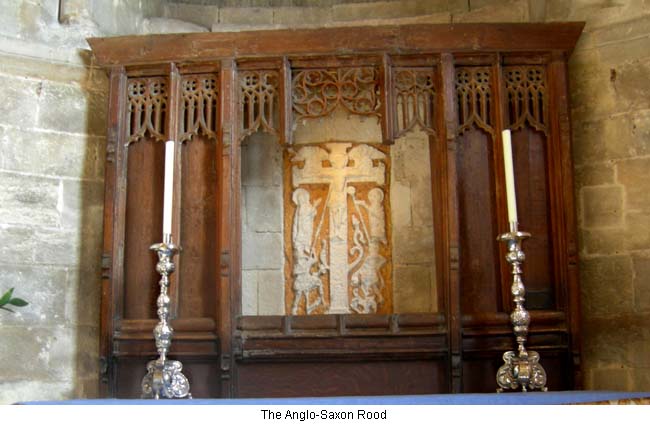
One of the abbey's oldest artifacts is the Saxon "rood" or
crucifix, which now stands upon the altar of the St. Anne chapel
in the south aisle, framed with part of a 15th-century oak
screen. The carving, once richly ornamented with gold and
jewels, depicts Christ upon the cross, flanked by Mary and John.
Two angels perch upon the arms of the cross, waiting to escort
Jesus to heaven; two Roman soldiers stand below, one holding up a
sop of vinegar, the other thrusting a spear into Christ's
side.
One of the abbey's strangest artifacts can be seen in a
glass case near the entrance and the gift shop: a plait of hair,
found within a lead coffin unearthed in 1839 during renovations
to the Abbey. Nothing else remained of the body that had
originally been interred in that coffin, except, the story goes,
a single bone that crumbled to dust when the coffin was open.
The plait appears to be a wig and resembles those of a much later
period, but is believed to predate the abbey's Saxon foundations.
Another unexpected find to occur during renovations was the
painted reredos that now stands upon an altar in the St. Laurence
chapel in the north aisle. This was discovered in 1813, when the
arches behind the high altar, which had been sealed up for
centuries, were unblocked. The panel had been painted over with
the Ten Commandments; when these were removed, the reredos was
revealed.
The lower half of the reredos depicts the Resurrection, with
angels waving censers and Roman soldiers wearing British plate
armor and carrying medieval poleaxes. An abbess stands to the
left of the scene, presumably the one who commissioned the work
and quite possibly the last abbess of Romsey, Elizabeth Ryprose,
as the panel has been dated to around 1525-1530. The top half
depicts a rather mixed bag of saints, including St. Benedict, St.
Francis, St. Scholastica (patron of nunneries), St. Roche
(pointing toward a plague sore on his leg), St. Jerome, and St.
Armel (with a small dragon). It also depicts two bishops,
including St. Swithun, bishop of Winchester from 852-862 and
patron saint of the diocese. The woman kneeling at the feet of
St. Francis is believed to be Lady Giacoma di Settisoli, a Roman
widow who ministered to the Franciscan brothers.
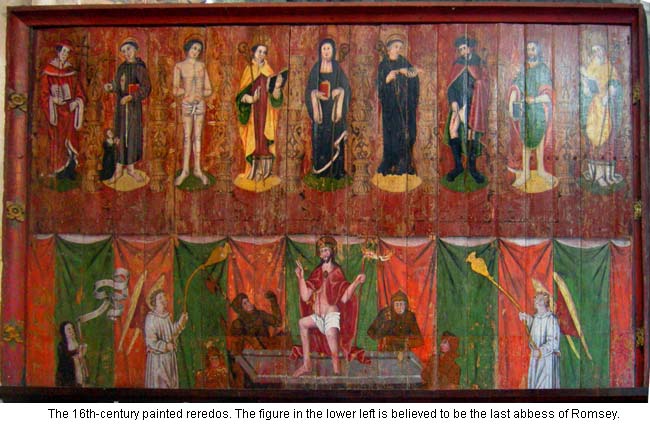
Another painting to emerge from this same hiding place is that
of a cleric, dating from the 15th century. The figure is
tonsured and wears a grey cloak; the red curtain in the
background is ornamented with flowers, stars and wolves' heads.
It is believed that this may be a pun suggesting the identity of
the figure: Thomas Wolsey (no relation to the cardinal), deacon
of the abbey around 1480. The name "Wolsey" comes from the Saxon
"Wulf-sige" or "wolf victory."
To see one of the most unusual and widely debated features of
Romsey Abbey, one must look up. The capitals of the easternmost
pillars of the north and south choir aisles are "historiated" --
that is, engraved with images that tell a tale. In most
churches, such capitals depict Bible stories, but here, they seem
to depict historical events, though historians can't quite agree
on what those might be.
The north capital depicts the aftermath of a bloody battle, with
decapitated heads, carrion birds snatching up body parts, and a
riderless horse fleeing the scene. In the center stand two kings
with drawn swords -- but angels stand behind each king, grasping
the weapons as if to prevent further bloodshed. One king grasps
the other by the beard. Some historians have noted that touching
a king's beard can represent an act of submission, but no
submissiveness is portrayed here; the first king seems intent on
ripping the second king's beard out by the roots, while the
second grasps the wrist of the first as if to prevent it.
The most commonly accepted theory is that this scene depicts the
Battle of Edington or Ethandune in 878, in which King Alfred
defeated Guthrum the Dane. Guthrum was not killed, and
ultimately accepted baptism with Alfred as his sponsor; the
resulting treaty freed Wessex from Danish rule. There is a
direct connection between the battle and the abbey, as the
battlefield was among the lands granted to the abbey by King
Edgar in 968.
The scene on the second capital is considerably murkier. One
side depicts a seated king and a standing angel holding a scroll
that reads ROBERxT mE fecit ("Robert made me"). In the center,
another figure holds a pyramid or obelisk. On the right are two
more seated figures holding a scroll that reads RobERT TUTE
CONSULe x d s -- a phrase that has yet to be translated
precisely. No one knows who "Robert" is -- whether he was a
patron or perhaps one of the masons. Unlike the kings upon the
other capital, however, these are clean-shaven, suggesting that
they depict Normans rather than Saxons.
Finally, one cannot fail to note the many lovely stained glass
windows in the abbey. Nearly all date from the 19th century,
except for one medieval panel that came from a window in the
church of St. Nicholas in Rouen. This dates from around
1540-1600, and was brought to England in the early 19th century.
The panel depicts the last scene in the journey of the soul:
"Salvation." In this scene, the soul is rising toward heaven,
escorted by an angel and assisted by "Love" (Charitie) and
"Prayer" (Oraison). Remaining earthbound and looking decidedly
disgruntled is the ostentatious almsgiver, holding out some coins
from his purse as if attempting to convince the angel of his
worth.
In a way, this window sums up much of the feel of Romsey Abbey.
Though it has seen scandal, controversy and turmoil over the
centuries, it has remained throughout a house of prayer, with its
eyes set firmly upon heaven -- a house where worship is taken as
seriously today as it was 1000 years ago.
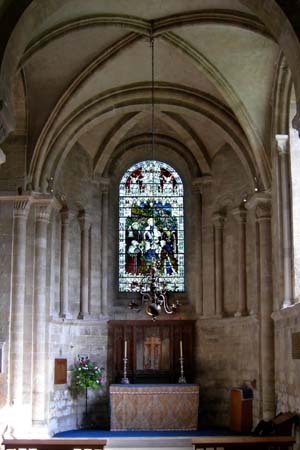
St. Anne's Chapel and Rood |
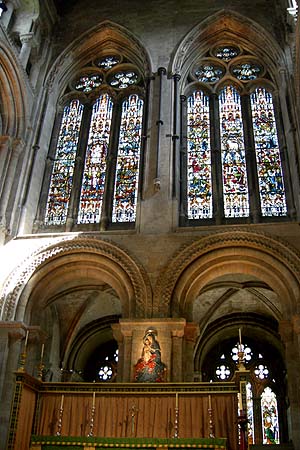
Romsey Abbey Altar |
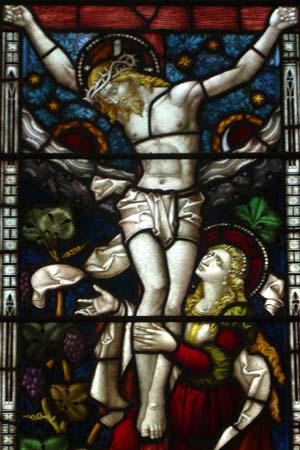
Victorian Stained Glass |
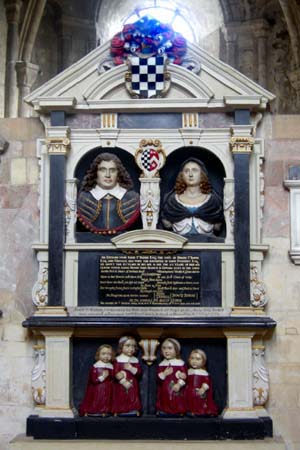
St. Barbe Memorial |
More Information:
We regret that we no longer have the resources to maintain up-to-date links and/or hours and pricing details for the various sites and attractions listed on this website. For more information about the location(s) listed above, please use your favorite search engine or visit Wikipedia.
Moira Allen has been writing and editing professionally for more than 30 years. She is the author of seven books and several hundred articles. She has been a lifelong Anglophile, and recently achieved her dream of living in England, spending nearly a year and a half in the history town of Hastings. Allen also hosts the Victorian history site VictorianVoices.net, a topical archive of thousands of articles from British and American Victorian periodicals. Allen currently resides in Maryland.
Article © 2008 Moira Allen
Photos © 2007 by Patrick and Moira Allen
|
